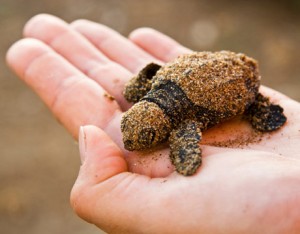Sea Turtles
 Sea turtles are large, air-breathing reptiles that inhabit tropical and subtropical seas throughout the world. Their shells consist of an upper part (carapace) and a lower section (plastron). Hard scales (or scutes) cover all but the leatherback, and the number and arrangement of these scutes can be used to determine the species.
Sea turtles are large, air-breathing reptiles that inhabit tropical and subtropical seas throughout the world. Their shells consist of an upper part (carapace) and a lower section (plastron). Hard scales (or scutes) cover all but the leatherback, and the number and arrangement of these scutes can be used to determine the species.
Sea turtles come in many different sizes, shapes and colors. The olive ridley is usually less than 100 pounds, while the leatherback typically ranges from 650 to 1,300 pounds! The upper shell, or carapace, of each sea turtle species ranges in length, color, shape and arrangement of scales.
Sea turtles do not have teeth, but their jaws have modified “beaks” suited to their particular diet. They do not have visible ears but have eardrums covered by skin. They hear best at low frequencies, and their sense of smell is excellent. Their vision underwater is good, but they are nearsighted out of water. Their streamlined bodies and large flippers make them remarkably adapted to life at sea. However, sea turtles maintain close ties to land.
Females must come ashore to lay their eggs in the sand; therefore, all sea turtles begin their lives as tiny hatchlings on land. Research on marine turtles has uncovered many facts about these ancient creatures. Most of this research has been focused on nesting females and hatchlings emerging from the nest, largely because they are the easiest to find and study.
Thousands of sea turtles around the world have been tagged to help collect information about their growth rates, reproductive cycles and migration routes. After decades of studying sea turtles, much has been learned. However, many mysteries still remain.
Sea Turtles and Humans
Sea turtles have long fascinated people and have figured prominently in the mythology and folklore of many cultures. In the Miskito Cays off the eastern coast of Nicaragua, the story of a kind “Turtle Mother,” still lingers. Unfortunately, the spiritual significance of sea turtles has not saved them from being exploited for both food and for profit. Millions of sea turtles once roamed the earth’s oceans, but now only a fraction remain.
Reproduction
Only females come ashore to nest; males rarely return to land after crawling into the sea as hatchlings. Most females return to nest on the beach where they were born (natal beach). Nesting seasons occur at different times around the world. In the U.S., nesting occurs from April through October. Most females nest at least twice during each mating season; some may nest up to ten times in a season. A female will not nest in consecutive years, typically skipping one or two years before returning.
Growth & Development
Researchers do not yet know how long baby turtles spend in the open sea, or exactly where they go. It is theorized that they spend their earliest, most vulnerable years floating around the sea in giant beds of sargasso weeds, where they do little more than eat and grow. Once turtles reach dinner-plate size, they appear at feeding grounds in nearshore waters. They grow slowly and take between 15 and 50 years to reach reproductive maturity, depending on the species. There is no way to determine the age of a sea turtle from its physical appearance. It is theorized that some species can live over 100 years.
Status of the Species
 The earliest known sea turtle fossils are about 150 million years old. In groups too numerous to count, they once navigated throughout the world’s oceans. But in just the past 100 years, demand for turtle meat, eggs, skin and colorful shells has dwindled their populations. Destruction of feeding and nesting habitats and pollution of the world’s oceans are all taking a serious toll on remaining sea turtle populations. Many breeding populations have already become extinct, and entire species are being wiped out. There could be a time in the near future when sea turtles are just an oddity found only in aquariums and natural history museums — unless action is taken today. This is why the efforts of property owners to provide Sea Turtle Friendly Lighting is so extremely important, and not only the environmental thing to do, but it is the responsible thing to do!
The earliest known sea turtle fossils are about 150 million years old. In groups too numerous to count, they once navigated throughout the world’s oceans. But in just the past 100 years, demand for turtle meat, eggs, skin and colorful shells has dwindled their populations. Destruction of feeding and nesting habitats and pollution of the world’s oceans are all taking a serious toll on remaining sea turtle populations. Many breeding populations have already become extinct, and entire species are being wiped out. There could be a time in the near future when sea turtles are just an oddity found only in aquariums and natural history museums — unless action is taken today. This is why the efforts of property owners to provide Sea Turtle Friendly Lighting is so extremely important, and not only the environmental thing to do, but it is the responsible thing to do!
Information provided by ConserveTurtles.org, Photos by TheDailyGreen.org







 Copyright 2011 SeaTurtleLighting.net a Division of
Copyright 2011 SeaTurtleLighting.net a Division of